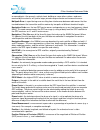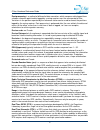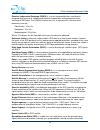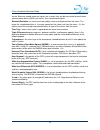- DL manuals
- C-Nav
- Car Navigation system
- 1000
- Hardware Reference Manual
C-Nav 1000 Hardware Reference Manual
Summary of 1000
Page 1
Dgnss systems hardware guide www.Cnavgnss.Com.
Page 2: C-Nav
Contact the c-nav® office or dealer nearest you: c-nav regional office and regional distributor contacts: north america: lafayette, la (head office): +1 337 210 0000 houston, tx: +1 713 468 1536 bothell, wa: +1 425 408 9190 mexico: +52 938 381 8973 south america: rio de janeiro - sales: +55 21 8082 ...
Page 3
C-nav hardware reference guide 3 contact information if you have a problem and cannot find the information you need during the installation or operation of a c-nav product, contact: c-nav support: phone: +1 337 210 0000 (24/7 support) fax: +1 337 261 0192 phones are answered 24 hours, 7 days a week,...
Page 4
C-nav hardware reference guide 4 table of contents contact information .......................................................................................................................... 3 notices ...................................................................................................
Page 5
C-nav hardware reference guide 5 iala receiver (mbx-3s, mbx-4) ................................................................................................................. 50 iala whip antenna dimensions ..............................................................................................
Page 6
C-nav hardware reference guide 6 table 3-13: c-nav2050 physical and environmental.............................................................................................................................. 38 table 3-14: c-nav2050 i/o messages .........................................................
Page 7
C-nav hardware reference guide 7 figure 3-50: c-navigator ii side-panel connectors ............................................................................................................................... 53 figure 3-51: c-navigator ii power supply ................................................
Page 8
C-nav hardware reference guide 8 chapter 1 ....................................................................... Overview c-nav and global navigation satellite systems traditional differential gnss positioning traditional differential gnss (dgnss ) relies on the concept that errors in position at ...
Page 9
C-nav hardware reference guide 9 ephemeris error occurs when the broadcast gnss message for the satellite’s orbital location is inaccurate. It is typical that the radial component of this error is the smallest; the along-track and cross-track errors are larger by an order of magnitude. The ‘line of ...
Page 10
C-nav hardware reference guide 10 receiver near large reflecting surfaces. The first line of defense is to use the combination of antenna cut-off angle and antenna location in order to minimize the problem. A second approach is to utilize software algorithms within the receiver to minimize the impac...
Page 11
C-nav hardware reference guide 11 the following table describes some of the statistical formulas and measures commonly used for gnss positional accuracy measurement: table 1-1: common accuracy measures used with gps *(mikhail, 1976) †(langley, 1991) **(national geodetic survey, 1986) common values u...
Page 12
C-nav hardware reference guide 12 c-nav subscription service description the c-navc 1 and c-navc 2 subscription services are a global system for the distribution of sbas corrections giving the user the ability to measure their position anywhere in the world with exceptional reliability and unprecede...
Page 13
C-nav hardware reference guide 13 together with the advanced processing algorithms, which makes the exceptional accuracy of the c-nav subscription service possible. Creating the corrections is just the first part. From our two processing centers, the differential corrections are then sent to the lan...
Page 14
C-nav hardware reference guide 14 the c-nav subscription service, now called c-navc 1 , remains unaffected and continues to provide customers with full gps clock and orbit correctors. C-navc 1 has proven reliability since 2000, featuring jpl/nasa clock and orbit based c-nav proprietary correction al...
Page 15
C-nav hardware reference guide 15 figure 1-1: c-nav corrections service network coverage l-band correction signal c-nav dgnss receivers can obtain c-nav signals from six (6) separate and independent geo- stationary communication satellites. The satellite based augmentation system (sbas) signals obta...
Page 16
C-nav hardware reference guide 16 table 1-2: l-band correction identifiers and modes l-band id sv name rtg sbas geo-stationary position am-1 americas net-1 yes no 97.65° w eua-1 europe/africa net-1 yes no 25° e pac-1 asia/pacific net-1 yes no 109° e am-2 americas net-2 yes no 142° w eua-2 europe/afr...
Page 17
C-nav hardware reference guide 17 chapter 2 ........................................................... Installation guide c-nav antenna installation notice this manual provides guidance on hardware installation for optimum performance. Prior to commencing any installation, discuss proposed mounting...
Page 18
C-nav hardware reference guide 18 active antennas (those with lna’s or amplifiers) create an electrical field around the antenna. These radiated emissions can interfere with other nearby antennas. Multiple gps antennas in close proximity to each other can create multipath and oscillations between ...
Page 19
C-nav hardware reference guide 19 antenna installation 1. Once the antenna location has been determined based on the previously mentioned criteria, mount the antenna onto the antenna mounting pole . This should be done on deck prior to climbing the mast as mounting the antenna aloft poses potential ...
Page 20
C-nav hardware reference guide 20 figure 2-3: c-nav antenna mounting pole dimensions.
Page 21
C-nav hardware reference guide 21 coaxial cable proper installation of coaxial cables is important to ensure successful communication between the antenna and the gnss receiver. Cable route when choosing a cable route for coaxial cable, consider the following: avoid running coaxial cable across, or...
Page 22
C-nav hardware reference guide 22 figure 2-4: c-nav3050 antenna tnc connector 2. Slacken the coaxial cable and attach to the antenna mounting pole with a zip-tie. This will prevent any undue strain on the cable connector and antenna. 3. With the cable connected to the antenna, run the cable down the...
Page 23
C-nav hardware reference guide 23 table 2-1: acceptable coaxial cable lengths cable type db loss per 100' db loss per 100m 7db loss point 18db loss point* rg-174 34.77 114.075 20.132' (6.136m) 51.769' (15.779m) rg-58 19.608 64.331 35.700' (10.881m) 91.799' (27.980m) rg-223 17.226 56.516 40.636' (12....
Page 24
C-nav hardware reference guide 24 chapter 3 ........................ C-nav dgnss hardware specifications c-nav3050 c-nav3050 receiver figure 3-1: c-nav3050 base plate dimensions without mounting brackets figure 3-2: c-nav3050 base plate dimensions with mounting brackets.
Page 25
C-nav hardware reference guide 25 table 3-1: c-nav3050 physical and environmental size (l x w x h): without mounting brackets: 164 x 117 x 60mm (6.47 x 4.60 x 2.37in) with mounting brackets: 164 x 166 x 62mm (6.47 x 6.52 x 2.46in) weight: 1.1 lbs (0.50 kg) external power: input voltage: output volta...
Page 26
C-nav hardware reference guide 26 c-nav3050 antennas table 3-4: c-nav3050 standard, base, and airborne antenna specifications part numbers standard: nav82-001020-3001lf base: nav82-001021-3001lf airborne: nav82-001022-3001lf frequency (frequency is dependent on software bundle options.) gps l1: 1575...
Page 27
C-nav hardware reference guide 27 figure 3-3: c-nav3050 standard gnss antenna offset • figure 3-3 is a drawing of the label on the standard gnss antenna (p/n nav82- 001020-3001lf). The phase center provided is based on ngs test results. Ngs does not currently provide glonass calibrated values. • to ...
Page 28
C-nav hardware reference guide 28 figure 3-5: c-nav3050 airborne (p/n nav82-001022-3001lf) antenna dimensions figure 3-6: c-nav3050 base (p/n nav82-001021-3001lf) antenna dimensions.
Page 29
C-nav hardware reference guide 29 figure 3-7: c-nav3050 standard & airborne antenna radiation pattern • optimal antenna performance is realized at elevations greater than 25º. • there is a 10db variation between 0º and 90º elevation (factor 10x); therefore, lower elevation satellites are always more...
Page 30
C-nav hardware reference guide 30 c-nav1010 c-nav1010 receiver figure 3-9: c-nav1010 receiver without mounting brackets figure 3-10: c-nav1010 receiver with mounting brackets.
Page 31
C-nav hardware reference guide 31 table 3-7: c-nav1010 physical and environmental size (l x w x h): w/o bracket size (l x w x h): with bracket weight: 1.7lbs (0.77 kg) external power input voltage: consumption: 9 vdc to 36 vdc connectors: i/o ports: dc power: gps/l-band antenna: l-band antenna: 2 x ...
Page 32
C-nav hardware reference guide 32 figure 3-11: c-nav1010 power supply c-nav1010 antennas table 3-10: c-nav1010 standard antenna specifications frequency 1525-1660 mhz gps l1 plus c-nav polarization right hand circular (rhcp) pre–amplifier 35db gain (+/-1.2db) noise figure filter rejection 9db @ 1690...
Page 33
C-nav hardware reference guide 33 figure 3-12: c-nav1010 standard antenna dimensions figure 3-13: c-nav1010 standard antenna radiation pattern table 3-11: c-nav1010 l-band antenna specifications (45° - 25°) part number p/n: nav82-001018-0001lf (45° - 25°) frequency 1525-1575 mhz inmarsat starfire™ p...
Page 34
C-nav hardware reference guide 34 operating temp -55 °c to +85°c finish skydrol resistant polyurethane enamel base iriditeper mil-c-5541 material 6061-t6 aluminum alloy base composite radome, impact, abrasion, uv, solvent, skydrol resistant, and fire retardant weight 5.2oz [146g] vibration >30g’s de...
Page 35
C-nav hardware reference guide 35 figure 3-16: c-nav1010 nav82-001018-0001lf radiation pattern (45° - 25°) table 3-12: c-nav1010 l-band antenna specifications ( part number nav82-001003-0001lf frequency 1525-1585 mhz inmarsat starfire™ polarization right hand circular (rhcp) pre–amplifier 25db gain ...
Page 36
C-nav hardware reference guide 36 figure 3-17: c-nav1010 nav82-001003-0001lf antenna and mounts ( figure 3-18: c-nav1010 nav82-001003-0001lf radiation pattern (.
Page 37
C-nav hardware reference guide 37 c-nav2050 c-nav2050 receiver figure 3-19: c-nav2050 front view figure 3-20: c-nav2050 top view.
Page 38
C-nav hardware reference guide 38 table 3-13: c-nav2050 physical and environmental size (l x w x h): weight: external power: input voltage: consumption: 10 vdc to 30 vdc 8 w connectors: i/o ports: dc power: rf connector: 2 x 7 pin lemo 4 pin lemo tnc antenna power 5 vdc, 0.05ma bias for lna temperat...
Page 39
C-nav hardware reference guide 39 figure 3-21: c-nav2050 power supply figure 3-22: c-nav2050 rs-232 to dp rs-422 moxa converter (moxtcc-801) • the c-nav2050 chassis/ground is internally connected to the power ground, thus the isolation mount adaptor may be needed when using dc power to prevent groun...
Page 40
C-nav hardware reference guide 40 c-nav2050 antennas table 3-16: c-nav2050 standard antenna part standard antenna part number 8250001-0 frequency 1525-1585 mhz, gps l1, plus inmarsat c-nav correction service 1217-1237 mhz, gps l2 l1 phase centre 58.7mm polarization right hand circular (rhcp) pre–amp...
Page 41
C-nav hardware reference guide 41 • to achieve the greatest level of accuracy, the absolute phase center values must be incorporated into your processing. Phase center information on this antenna is found on the antenna bottom, and in the figure below. Figure 3-24: c-nav2050 standard antenna phase c...
Page 42
C-nav hardware reference guide 42 figure 3-27: c-nav2050 standard & airborne antenna radiation patterns • optimal antenna performance is realized at elevations greater than 30º. • there is a 10db variation between 0º and 90º elevation (factor 10x); therefore, lower elevation satellites are always mo...
Page 43
C-nav hardware reference guide 43 table 3-18: c-nav2050r antenna part l-band c-nav2050r antenna part number 825r003-0 frequency 1525-1576 mhz inmarsat c-nav correction service polarization right hand circular (rhcp) pre–amplifier 25db gain min. (to coax end) noise figure 1.0db typical impedance 50 o...
Page 44
C-nav hardware reference guide 44 figure 3-30: c-nav2050r antenna radiation pattern figure 3-31: c-nav2050r antenna lna wide-band response • optimal antenna performance is realized at elevations between 10º and 50º. • there is an 8db variation between 40º and 90º elevation (factor 6.3x); therefore, ...
Page 45
C-nav hardware reference guide 45 c-nav1000 c-nav1000 receiver figure 3-32: c-nav1000 receiver front view (mm) figure 3-33: c-nav1000 receiver top view (mm) figure 3-34: c-nav1000 receiver clearance area.
Page 46
C-nav hardware reference guide 46 figure 3-35: c-nav1000 rs-422 to dp rs-232 moxa converter (moxtcc-801) c-nav1000 display figure 3-36: c-nav1000 display front view (mm) figure 3-37: c-nav1000 display top view (mm).
Page 47
C-nav hardware reference guide 47 c-nav1000 antennas beacon receiver specifications beacon frequency range 283.5 - 325.0 khz beacon lna gain 34 db l- band receiver specifications l- band frequency range n/ a l- band lna gain n/ a power input specifications input voltage 4.0 - 13 vdc input current 50...
Page 48
C-nav hardware reference guide 48 c-nav1000 display mounting options gimbal mount figure 3-40: gimbal mount clearance area panel mount figure 3-41: panel mount frame dimensions (mm) figure 3-42: clearance distance behind the display (panel mount).
Page 49
C-nav hardware reference guide 49 figure 3-43: panel mount hole dimensions (mm) figure 3-44: panel mounting c-nav1000 display figure 3-45: c-nav1000 display panel mounted.
Page 50
C-nav hardware reference guide 50 iala gps system iala receiver (mbx-3s, mbx-4) operational specifications: operational specificationitem specification frequency range 283.5 - 325 khz channels 2 input sensitivity 2.5 μv/m for 10 db snr @ 100 bps msk rate acquisition time msk bit rate 100, 200, or au...
Page 51
C-nav hardware reference guide 51 figure 3-46: mbx-4 receiver with mounting bracket (top mounted) figure 3-47: bottom-view mbx-4 with mounting bracket (bottom mounted) figure 3-48: iala receiver mounting bracket dimensions.
Page 52
C-nav hardware reference guide 52 iala whip antenna dimensions this antenna, referred to as an e-field whip antenna, is sensitive to the electrical field of contained in the base of the mba-3, which together amplify signals in the 283.5 to 325.0 khz frequency band. The mba-3 is compatible with stand...
Page 53
C-nav hardware reference guide 53 c-navigator ii c-navigator ii control and display unit figure 3-49: c-navigator ii display (front view) figure 3-50: c-navigator ii side-panel connectors figure 3-51: c-navigator ii power supply.
Page 54
C-nav hardware reference guide 54 mechanical specifications size (l x w x h) 82.2mm (3.2”) x 340mm (13.4”) x 260mm (10.2”) weight 4.8 kg (10.6 lbs) display 10.4” tft lcd, 1024x768, 400 nit, resistive ts cpu 1.0 ghz via 7c, 512 mb, 2gb cf power input specifications input voltage 12 vdc +/- 5% (24-12v...
Page 55
C-nav hardware reference guide 55 c-navigator ii mounting options option #1: allows mounting from ceiling, wall or desktop with fully adjustable positioning. Figure 3-52: ram 100 75 vesa base (w/ steel reinforce) / ram-d-246u-in1 this piece fits to the standard vesa mounting holes on the back of the...
Page 56
C-nav hardware reference guide 56 option #2: desktop stand figure 3-55: flat screen table stand (for c-navigator ii) / chifsb018blk option #3: wall mount figure 3-56: tilting vesa wall mount (for c-navigator ii) / peest630
Page 57
C-nav hardware reference guide 57 option #4: front panel mount use this adaptor if unable to secure display from the back. Appropriate hardware is included to secure the c-navigator to the front panel mount prior to mounting. Bolt thread size is m4 x 6mm figure 3-57: front mount kit (for c-navigator...
Page 58
C-nav hardware reference guide 58 option #5: 19” rack mount use this adaptor if installing the c-navigator to a rack. The 19” rack mount takes up 7u of rack space and is 12 ¼” in height. Appropriate hardware is included to secure the c-navigator to the rack mount prior to mounting. Bolt tread size i...
Page 59
C-nav hardware reference guide 59 figure 3-59: c-navigator ii (side usb-port model) outline diagram (mm) both inside and outside mounting holes on vesa mount are m4 x 16mm in size. Inside holes have 75mm spacing outside holes have 100mm spacing.
Page 60
C-nav hardware reference guide 60 figure 3-60: c-navigator ii cut-out diagram (mm) cut-out panel includes hardware to facilitate bolting of the c-navigator from the rear via m4 x 16mm sized bolts (6 places) or from the front via m4 or #10 sized bolts (4 places, rev. A only).
Page 61
C-nav hardware reference guide 61 figure 3-61: c-navigator ii rev. A (front usb-port model) outline diagram (mm).
Page 62
C-nav hardware reference guide 62 c-navigator ii lcd touch-screen care and cleaning lcd screens are not like ordinary monitor screens in that they are not made of glass, rather they are made up of a soft film that can easily be damaged by abrasive cloth or paper, chloride and other chemicals found i...
Page 63
C-nav hardware reference guide 63 chapter 4 ................................................... Hardware accessories huber + suhner lightning protectors model no. 3403.17.0045 specifications.
Page 64
C-nav hardware reference guide 64 model no. 3403.17.0045 dimensions figure 4-1: huber + suhner model no. 3403.17.0045.
Page 65
C-nav hardware reference guide 65 model no. 3402.17.0070 specifications.
Page 66
C-nav hardware reference guide 66 model no. 3402.17.0070 dimensions figure 4-2: huber + suhner model no. 3402.17.0070
Page 67
C-nav hardware reference guide 67 huber + suhner lightning protector mounting instructions.
Page 68
C-nav hardware reference guide 68.
Page 69
C-nav hardware reference guide 69 moxa converters tcc-80i tcc-80i specifications.
Page 70
C-nav hardware reference guide 70 tcc-80i dimensions figure 4-3: moxa tcc-80i converter dimensions tcc-82.
Page 71
C-nav hardware reference guide 71 tcc-82 specifications tcc-82 dimensions figure 4-4: tcc-82 converter dimensions.
Page 72
C-nav hardware reference guide 72 times-microwave lmr400 coaxial cable lmr400 specifications.
Page 73
C-nav hardware reference guide 73 figure 4-5: lmr400 attenuation vs. Frequency graph lmr400 connectors figure 4-6: lmr400 connectors.
Page 74
C-nav hardware reference guide 74.
Page 75
C-nav hardware reference guide 75 chapter 5 ...................... Technical reference and interface guide coaxial cable terminating coaxial cable (times microwave systems) 1. Flush cut the cable squarely figure 5-1: components for termination of coaxial cable 2. Slide the heat shrink boot over the ...
Page 76
C-nav hardware reference guide 76 3. Debur the center conductor using a deburring tool or a file. Figure 5-3: duburring tool 4. Insert the cable into the opposite end of the prep/strip tool and rotate clockwise until the tool spins freely. Remove the tool (if you are using a knife to complete this s...
Page 77
C-nav hardware reference guide 77 5. Apply a small amount of rma flux around the exposed center conductor. Figure 5-5: rma flux application 6. Place a piece of solder into the pin until it bottoms. Trim the solder flush with the back of the pin with a knife. Place a shim over the cable and up agains...
Page 78
C-nav hardware reference guide 78 7. Remove the shim and slide the connector over the pin. Once the connector has been pushed all the way on so that the connector bottoms out onto the core, slide the ferrule over the braid, making an impression in the braid at the point that it protrudes between the...
Page 79
C-nav hardware reference guide 79 coax-seal® weather sealant installation 1. Shown below is a short pigtail of rg-59u coax cable terminated in a snap and seal "f" connector which is then joined to a female-female adapter or barrel connector. Figure 5-9: rg-59u coaxial cable 2. The next few photos wi...
Page 80
C-nav hardware reference guide 80 3. The second cable with connector is attached to the barrel adapter and was tightened. The connector on the right has an o ring and is sealed to the coax internally with silicone grease. Figure 5-11: coax-seal roll 4. Coax-seal is a putty like material in tape form...
Page 81
C-nav hardware reference guide 81 5. Note that the first wrap comes back on itself exactly and the second run starts the diagonal wrap. Wrap from the coax cover toward the fitting with one half overlap with each winding. The last wrap again comes straight back over the previous wrap without a diagon...
Page 82
C-nav hardware reference guide 82 table 4-1: coax-seal product specifications coax-seal product specifications packaging: • 60” consumer rolls, 3/32" thick x 1/2" wide, in retail packaging for pegboard or counter display. • 12’ industrial rolls, 3/32" thick x 1/2" wide or 1” wide. • pre-cut strips, ...
Page 83
C-nav hardware reference guide 83 chapter 6 ........................................................................ Glossary troubleshooting the following information is provided for the use and operation of c-nav dgnss systems. It is recommended that you read through this chapter before calling c-...
Page 84
C-nav hardware reference guide 84 intermittent gps loss when gnss lock is intermittent, the antenna cable may be disconnected or loose. Check that all connections are secured properly. Protect the cable/antenna connection with a weather- sealant tape such as coax-seal. If the sealant tape is not pro...
Page 85
C-nav hardware reference guide 85 loss of settings when the unit is powered off c-nav gnss receiver configuration parameter settings are stored in battery-backed ram (random access memory). The internal lithium battery has a 10-year life span. You can assume the lithium battery has failed when the r...
Page 86
C-nav hardware reference guide 86 abbreviations 1pps - 1 pulse per second 2drms – twice the distance root mean square a/s – antispoofing apc – antenna phase center ber - bit error rate bps – bits per second bsw – british standard whitworth c/a – coarse/acquisition cep – circular error probable cdu –...
Page 87
C-nav hardware reference guide 87 ign - ignition imo – international maritime organization inmarsat – international maritime satellite consortium, ltd. Ins – inertial navigation system iodc – issue of data, clock itrf – international terrestrial reference frame jpl – jet propulsion laboratory kbps –...
Page 88
C-nav hardware reference guide 88 rinex – receiver independent exchange rms – root mean square rtcm - radio technical commission for maritime services rtg – real-time gypsy rtk – real-time kinematic s/a – selective availability sbas – satellite based augmentation system sep – spherical error probabl...
Page 89
C-nav hardware reference guide 89 definitions 1 pulse per second (1pps) is a precision electronic pulse output (at ttl levels) from the gps receiver that marks exact second intervals. It is used for precise timing and to synchronize sensors and acquisition computers. .Yym files see meteorological fi...
Page 90
C-nav hardware reference guide 90 deviations from the mean. The deviations are not squared like they are for the standard deviation; the absolute values of the deviations are used. Azimuth the azimuth of a line is its direction as given by the angle between the meridian and the line measured in a cl...
Page 91
C-nav hardware reference guide 91 circular error probable (cep) is a measurement of precision using standard deviation that is applicable in horizontal stations. Probability for cep is 50%, meaning that if 100 observations are made, half of them will be within the circular error probable with radius...
Page 92
C-nav hardware reference guide 92 f igure 6-1: dte to dce rs-232 pin assignments deflection of the vertical is the angle between the perpendicular to the geoid (plumb line) and the perpendicular to the ellipsoid. Dgps see differential gps. Differencing is a technique used in baseline processing to r...
Page 93
C-nav hardware reference guide 93 dynamic mode when a gps receiver operates in dynamic mode, it assumes that it is in motion and certain algorithms for gps position fixing are enabled in order to calculate a tighter position fix. Dynamic positioning (gps) is the determination of the position of a mo...
Page 94
C-nav hardware reference guide 94 geoidal height is the undulation of the geoid above or below the reference ellipsoid. Geographical information system (gis) is a computer system capable of assembling, storing, manipulating, updating, analyzing and displaying geographically referenced information, i...
Page 95
C-nav hardware reference guide 95 l-band isthe group of radio frequencies extending from approximately 400mhz to approximately 1600mhz. The gps carrier frequencies l1 (1575.4mhz) and l2 (1227.6 mhz) are in the l-bandrange. L1 carrier frequency is the primary l-band carrier used by gps satellites to ...
Page 96
C-nav hardware reference guide 96 or more objects—the ground, a vehicle, boat, building or some other surface—and once received by the antenna, will yield a larger pseudo-range estimate and increase the error. Multipath error is a positioning error resulting from interference between radio waves tha...
Page 97
C-nav hardware reference guide 97 post-processing is a method of differential data correction, which compares data logged from a known reference point to data logged by a roving receiver over the same period of time. Variations in the position reported by the reference station can be used to correct...
Page 98
C-nav hardware reference guide 98 receiver independent exchange (rinex) is a set of standard definitions and formats designed to be receiver or software manufacturer independent and to promote the free exchange of gps data. The rinex file format consists of separate files, the three most commonly us...
Page 99
C-nav hardware reference guide 99 secure. Because spread spectrum signals are so wide, they can be transmitted at much lower spectral power density (watts per hertz), than narrow band signals. Standard deviation is a measure of how widely values are dispersed from the mean. The larger the standard d...



































































































